Understanding and Leading Change Assignment | Starbucks
VerifiedAdded on 2021/02/19
|13
|3908
|25
AI Summary
Contribute Materials
Your contribution can guide someone’s learning journey. Share your
documents today.
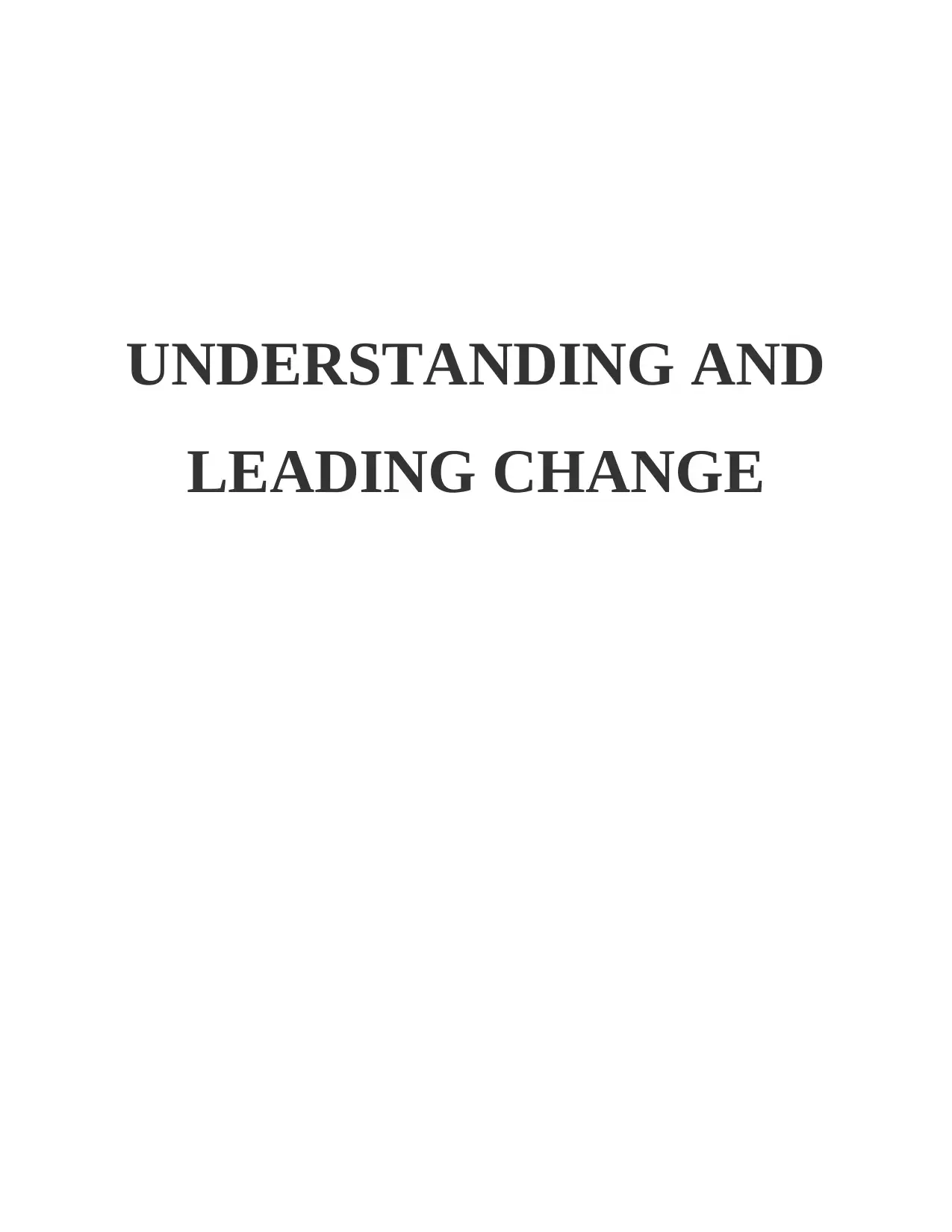
UNDERSTANDING AND
LEADING CHANGE
LEADING CHANGE
Secure Best Marks with AI Grader
Need help grading? Try our AI Grader for instant feedback on your assignments.
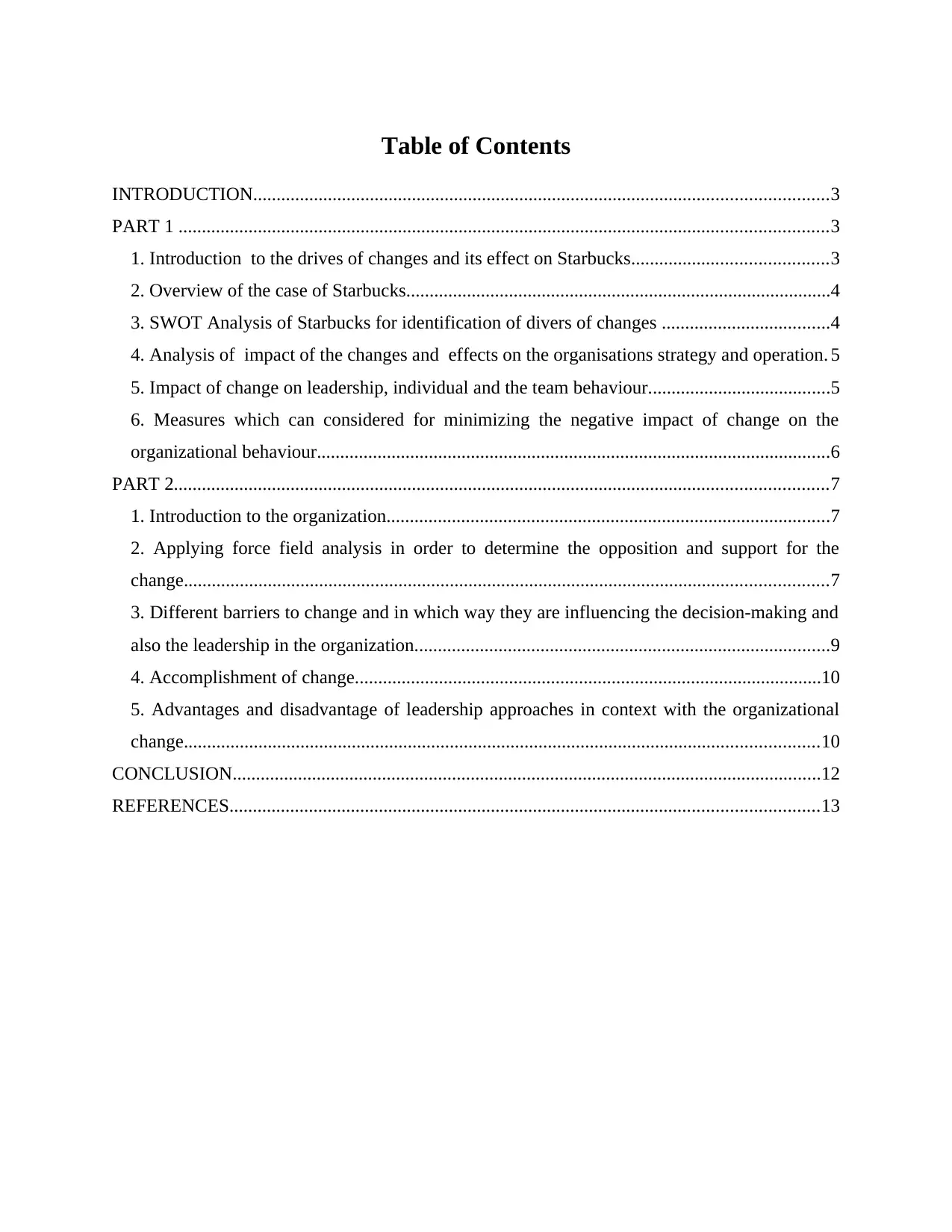
Table of Contents
INTRODUCTION...........................................................................................................................3
PART 1 ...........................................................................................................................................3
1. Introduction to the drives of changes and its effect on Starbucks..........................................3
2. Overview of the case of Starbucks...........................................................................................4
3. SWOT Analysis of Starbucks for identification of divers of changes ....................................4
4. Analysis of impact of the changes and effects on the organisations strategy and operation. 5
5. Impact of change on leadership, individual and the team behaviour.......................................5
6. Measures which can considered for minimizing the negative impact of change on the
organizational behaviour..............................................................................................................6
PART 2............................................................................................................................................7
1. Introduction to the organization...............................................................................................7
2. Applying force field analysis in order to determine the opposition and support for the
change..........................................................................................................................................7
3. Different barriers to change and in which way they are influencing the decision-making and
also the leadership in the organization.........................................................................................9
4. Accomplishment of change....................................................................................................10
5. Advantages and disadvantage of leadership approaches in context with the organizational
change........................................................................................................................................10
CONCLUSION..............................................................................................................................12
REFERENCES..............................................................................................................................13
INTRODUCTION...........................................................................................................................3
PART 1 ...........................................................................................................................................3
1. Introduction to the drives of changes and its effect on Starbucks..........................................3
2. Overview of the case of Starbucks...........................................................................................4
3. SWOT Analysis of Starbucks for identification of divers of changes ....................................4
4. Analysis of impact of the changes and effects on the organisations strategy and operation. 5
5. Impact of change on leadership, individual and the team behaviour.......................................5
6. Measures which can considered for minimizing the negative impact of change on the
organizational behaviour..............................................................................................................6
PART 2............................................................................................................................................7
1. Introduction to the organization...............................................................................................7
2. Applying force field analysis in order to determine the opposition and support for the
change..........................................................................................................................................7
3. Different barriers to change and in which way they are influencing the decision-making and
also the leadership in the organization.........................................................................................9
4. Accomplishment of change....................................................................................................10
5. Advantages and disadvantage of leadership approaches in context with the organizational
change........................................................................................................................................10
CONCLUSION..............................................................................................................................12
REFERENCES..............................................................................................................................13
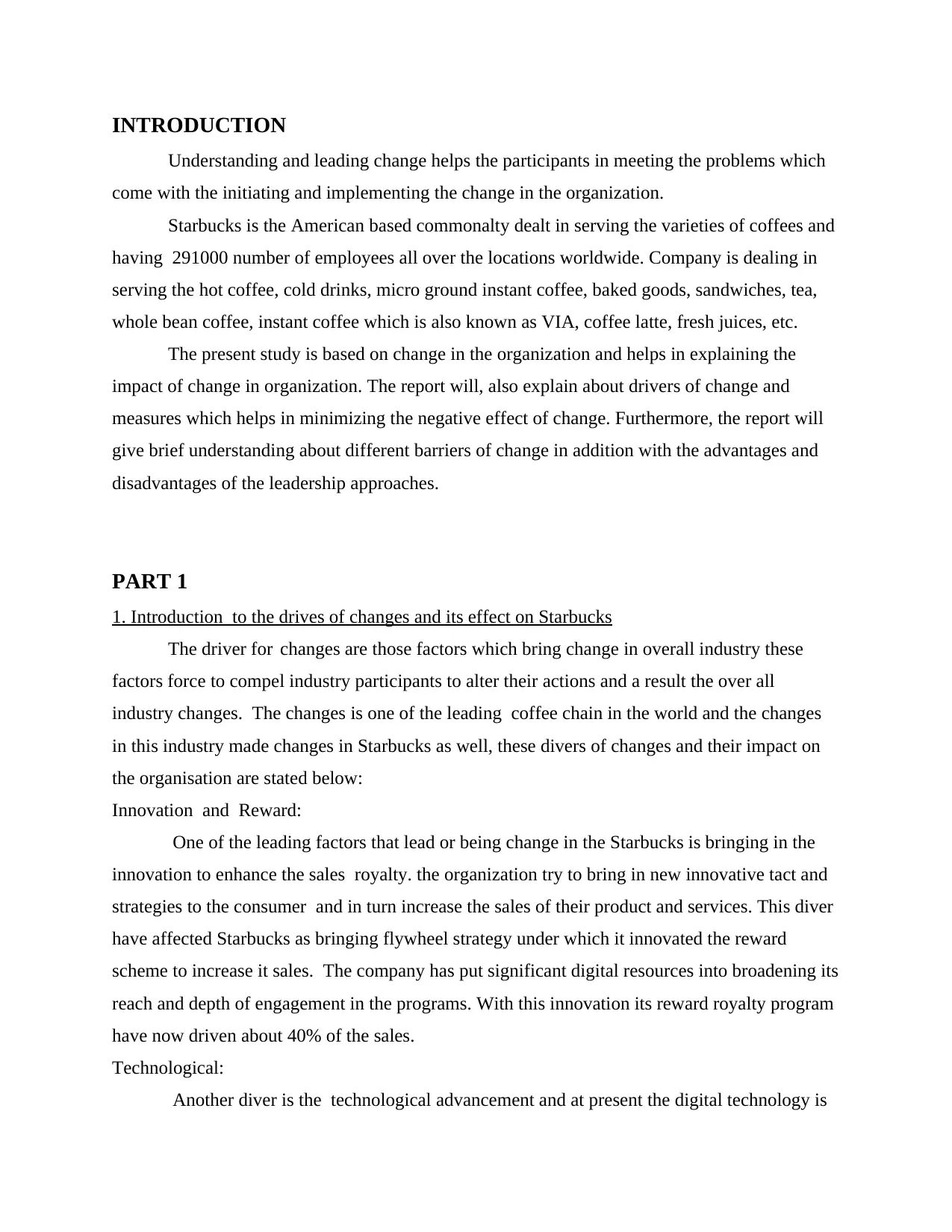
INTRODUCTION
Understanding and leading change helps the participants in meeting the problems which
come with the initiating and implementing the change in the organization.
Starbucks is the American based commonalty dealt in serving the varieties of coffees and
having 291000 number of employees all over the locations worldwide. Company is dealing in
serving the hot coffee, cold drinks, micro ground instant coffee, baked goods, sandwiches, tea,
whole bean coffee, instant coffee which is also known as VIA, coffee latte, fresh juices, etc.
The present study is based on change in the organization and helps in explaining the
impact of change in organization. The report will, also explain about drivers of change and
measures which helps in minimizing the negative effect of change. Furthermore, the report will
give brief understanding about different barriers of change in addition with the advantages and
disadvantages of the leadership approaches.
PART 1
1. Introduction to the drives of changes and its effect on Starbucks
The driver for changes are those factors which bring change in overall industry these
factors force to compel industry participants to alter their actions and a result the over all
industry changes. The changes is one of the leading coffee chain in the world and the changes
in this industry made changes in Starbucks as well, these divers of changes and their impact on
the organisation are stated below:
Innovation and Reward:
One of the leading factors that lead or being change in the Starbucks is bringing in the
innovation to enhance the sales royalty. the organization try to bring in new innovative tact and
strategies to the consumer and in turn increase the sales of their product and services. This diver
have affected Starbucks as bringing flywheel strategy under which it innovated the reward
scheme to increase it sales. The company has put significant digital resources into broadening its
reach and depth of engagement in the programs. With this innovation its reward royalty program
have now driven about 40% of the sales.
Technological:
Another diver is the technological advancement and at present the digital technology is
Understanding and leading change helps the participants in meeting the problems which
come with the initiating and implementing the change in the organization.
Starbucks is the American based commonalty dealt in serving the varieties of coffees and
having 291000 number of employees all over the locations worldwide. Company is dealing in
serving the hot coffee, cold drinks, micro ground instant coffee, baked goods, sandwiches, tea,
whole bean coffee, instant coffee which is also known as VIA, coffee latte, fresh juices, etc.
The present study is based on change in the organization and helps in explaining the
impact of change in organization. The report will, also explain about drivers of change and
measures which helps in minimizing the negative effect of change. Furthermore, the report will
give brief understanding about different barriers of change in addition with the advantages and
disadvantages of the leadership approaches.
PART 1
1. Introduction to the drives of changes and its effect on Starbucks
The driver for changes are those factors which bring change in overall industry these
factors force to compel industry participants to alter their actions and a result the over all
industry changes. The changes is one of the leading coffee chain in the world and the changes
in this industry made changes in Starbucks as well, these divers of changes and their impact on
the organisation are stated below:
Innovation and Reward:
One of the leading factors that lead or being change in the Starbucks is bringing in the
innovation to enhance the sales royalty. the organization try to bring in new innovative tact and
strategies to the consumer and in turn increase the sales of their product and services. This diver
have affected Starbucks as bringing flywheel strategy under which it innovated the reward
scheme to increase it sales. The company has put significant digital resources into broadening its
reach and depth of engagement in the programs. With this innovation its reward royalty program
have now driven about 40% of the sales.
Technological:
Another diver is the technological advancement and at present the digital technology is

one of the key drives for every organisation. Under this organisation bring in new digital
technologies to give new experiences to consumers as well enhancing their operational efficiency
(Doppelt, 2017). In this direction the Starbucks have brought in Fly wheel strategy under which
it have developed a new mobile pay ecosystem as a payment innovation for its consumers. the
users of this is mobile pay System have more used than Apple's, which depict the success of
this digital technology innovation.
Competitors:
Competition and the competitors in the market pace are yet another drives that bring in
changes in the strategies and actions of an organisation. The business bring in survive in the cut
throat competition and to gain competitive advantages. In this direction the changes which have
made by Starbucks is the making the ordering to the Starbucks outlet more convenient. For this
mobile order and pay though its Starbucks delivers programs are made to gain a upper hand
over its competitors. From a customer perspective, Starbucks Delivers is being seamlessly
integrated into the Uber Eats mobile app, enabling full beverage customization and fully
integrating into our store operations to ensure a premium Starbucks Experience.
Consumers:
2. Overview of the case of Starbucks
Starbucks keeps reinvesting heavily in its technological innovation strategies for
attaining the growth in its business. Starbucks have brought in its first Chief digital officer as a
tech led innovation strategy. The innovations ideas are fuel for the fuel for the future and the
Starbucks continue to build on this heritage. in this direct a innovation have been brought by the
organisation through development of a Fly wheel strategy which focuses on rewards,
personalisation, ordering and payments methods making them more convenient and easy for
consumers (Govindarajan, 2016). The organisation have developed and changes its strategy to
achieve its goals and gain competitive advantage in the coffee chain industry. With this
strategy new innovation and tech development have been brought in to give a changes and
enhanced service, ordering and payment experiences to its consumers all over the world. The
Fly wheel strategy is quite a success for Starbucks.
3. SWOT Analysis of Starbucks for identification of divers of changes
The SWOT analysis of Starbucks define the internal factors that lead to change the
strategies in organisation and sit impact on overall strategies:
technologies to give new experiences to consumers as well enhancing their operational efficiency
(Doppelt, 2017). In this direction the Starbucks have brought in Fly wheel strategy under which
it have developed a new mobile pay ecosystem as a payment innovation for its consumers. the
users of this is mobile pay System have more used than Apple's, which depict the success of
this digital technology innovation.
Competitors:
Competition and the competitors in the market pace are yet another drives that bring in
changes in the strategies and actions of an organisation. The business bring in survive in the cut
throat competition and to gain competitive advantages. In this direction the changes which have
made by Starbucks is the making the ordering to the Starbucks outlet more convenient. For this
mobile order and pay though its Starbucks delivers programs are made to gain a upper hand
over its competitors. From a customer perspective, Starbucks Delivers is being seamlessly
integrated into the Uber Eats mobile app, enabling full beverage customization and fully
integrating into our store operations to ensure a premium Starbucks Experience.
Consumers:
2. Overview of the case of Starbucks
Starbucks keeps reinvesting heavily in its technological innovation strategies for
attaining the growth in its business. Starbucks have brought in its first Chief digital officer as a
tech led innovation strategy. The innovations ideas are fuel for the fuel for the future and the
Starbucks continue to build on this heritage. in this direct a innovation have been brought by the
organisation through development of a Fly wheel strategy which focuses on rewards,
personalisation, ordering and payments methods making them more convenient and easy for
consumers (Govindarajan, 2016). The organisation have developed and changes its strategy to
achieve its goals and gain competitive advantage in the coffee chain industry. With this
strategy new innovation and tech development have been brought in to give a changes and
enhanced service, ordering and payment experiences to its consumers all over the world. The
Fly wheel strategy is quite a success for Starbucks.
3. SWOT Analysis of Starbucks for identification of divers of changes
The SWOT analysis of Starbucks define the internal factors that lead to change the
strategies in organisation and sit impact on overall strategies:
Secure Best Marks with AI Grader
Need help grading? Try our AI Grader for instant feedback on your assignments.
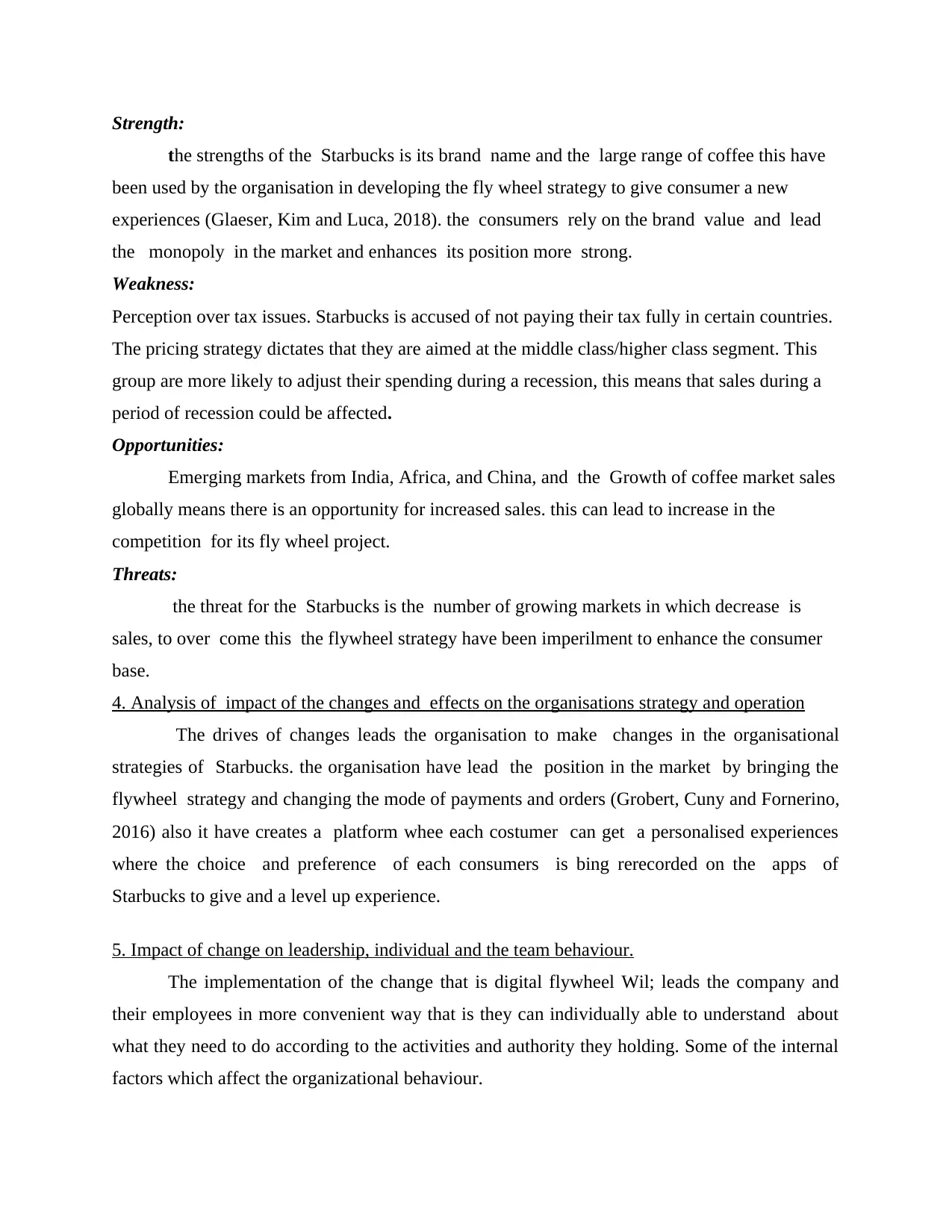
Strength:
the strengths of the Starbucks is its brand name and the large range of coffee this have
been used by the organisation in developing the fly wheel strategy to give consumer a new
experiences (Glaeser, Kim and Luca, 2018). the consumers rely on the brand value and lead
the monopoly in the market and enhances its position more strong.
Weakness:
Perception over tax issues. Starbucks is accused of not paying their tax fully in certain countries.
The pricing strategy dictates that they are aimed at the middle class/higher class segment. This
group are more likely to adjust their spending during a recession, this means that sales during a
period of recession could be affected.
Opportunities:
Emerging markets from India, Africa, and China, and the Growth of coffee market sales
globally means there is an opportunity for increased sales. this can lead to increase in the
competition for its fly wheel project.
Threats:
the threat for the Starbucks is the number of growing markets in which decrease is
sales, to over come this the flywheel strategy have been imperilment to enhance the consumer
base.
4. Analysis of impact of the changes and effects on the organisations strategy and operation
The drives of changes leads the organisation to make changes in the organisational
strategies of Starbucks. the organisation have lead the position in the market by bringing the
flywheel strategy and changing the mode of payments and orders (Grobert, Cuny and Fornerino,
2016) also it have creates a platform whee each costumer can get a personalised experiences
where the choice and preference of each consumers is bing rerecorded on the apps of
Starbucks to give and a level up experience.
5. Impact of change on leadership, individual and the team behaviour.
The implementation of the change that is digital flywheel Wil; leads the company and
their employees in more convenient way that is they can individually able to understand about
what they need to do according to the activities and authority they holding. Some of the internal
factors which affect the organizational behaviour.
the strengths of the Starbucks is its brand name and the large range of coffee this have
been used by the organisation in developing the fly wheel strategy to give consumer a new
experiences (Glaeser, Kim and Luca, 2018). the consumers rely on the brand value and lead
the monopoly in the market and enhances its position more strong.
Weakness:
Perception over tax issues. Starbucks is accused of not paying their tax fully in certain countries.
The pricing strategy dictates that they are aimed at the middle class/higher class segment. This
group are more likely to adjust their spending during a recession, this means that sales during a
period of recession could be affected.
Opportunities:
Emerging markets from India, Africa, and China, and the Growth of coffee market sales
globally means there is an opportunity for increased sales. this can lead to increase in the
competition for its fly wheel project.
Threats:
the threat for the Starbucks is the number of growing markets in which decrease is
sales, to over come this the flywheel strategy have been imperilment to enhance the consumer
base.
4. Analysis of impact of the changes and effects on the organisations strategy and operation
The drives of changes leads the organisation to make changes in the organisational
strategies of Starbucks. the organisation have lead the position in the market by bringing the
flywheel strategy and changing the mode of payments and orders (Grobert, Cuny and Fornerino,
2016) also it have creates a platform whee each costumer can get a personalised experiences
where the choice and preference of each consumers is bing rerecorded on the apps of
Starbucks to give and a level up experience.
5. Impact of change on leadership, individual and the team behaviour.
The implementation of the change that is digital flywheel Wil; leads the company and
their employees in more convenient way that is they can individually able to understand about
what they need to do according to the activities and authority they holding. Some of the internal
factors which affect the organizational behaviour.
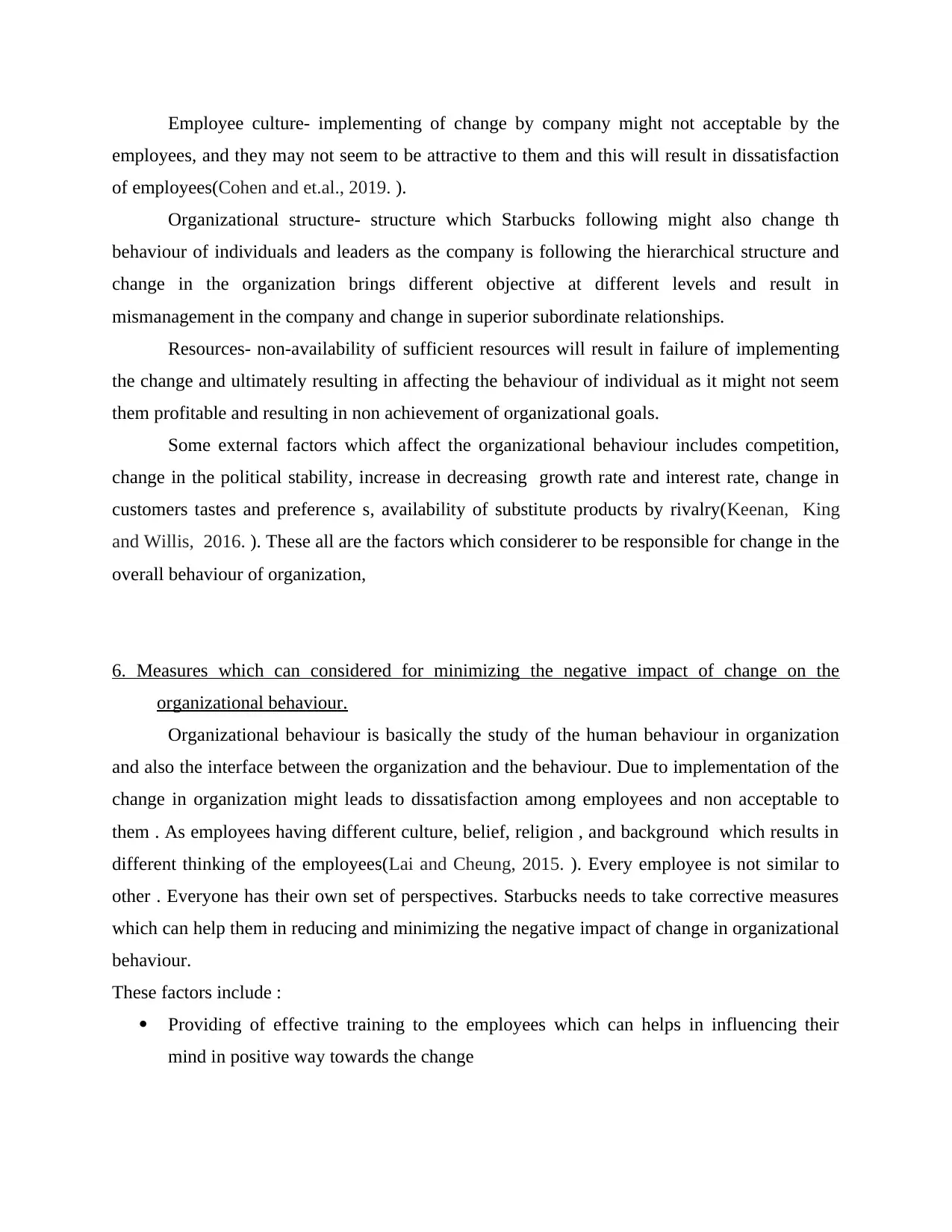
Employee culture- implementing of change by company might not acceptable by the
employees, and they may not seem to be attractive to them and this will result in dissatisfaction
of employees(Cohen and et.al., 2019. ).
Organizational structure- structure which Starbucks following might also change th
behaviour of individuals and leaders as the company is following the hierarchical structure and
change in the organization brings different objective at different levels and result in
mismanagement in the company and change in superior subordinate relationships.
Resources- non-availability of sufficient resources will result in failure of implementing
the change and ultimately resulting in affecting the behaviour of individual as it might not seem
them profitable and resulting in non achievement of organizational goals.
Some external factors which affect the organizational behaviour includes competition,
change in the political stability, increase in decreasing growth rate and interest rate, change in
customers tastes and preference s, availability of substitute products by rivalry(Keenan, King
and Willis, 2016. ). These all are the factors which considerer to be responsible for change in the
overall behaviour of organization,
6. Measures which can considered for minimizing the negative impact of change on the
organizational behaviour.
Organizational behaviour is basically the study of the human behaviour in organization
and also the interface between the organization and the behaviour. Due to implementation of the
change in organization might leads to dissatisfaction among employees and non acceptable to
them . As employees having different culture, belief, religion , and background which results in
different thinking of the employees(Lai and Cheung, 2015. ). Every employee is not similar to
other . Everyone has their own set of perspectives. Starbucks needs to take corrective measures
which can help them in reducing and minimizing the negative impact of change in organizational
behaviour.
These factors include :
Providing of effective training to the employees which can helps in influencing their
mind in positive way towards the change
employees, and they may not seem to be attractive to them and this will result in dissatisfaction
of employees(Cohen and et.al., 2019. ).
Organizational structure- structure which Starbucks following might also change th
behaviour of individuals and leaders as the company is following the hierarchical structure and
change in the organization brings different objective at different levels and result in
mismanagement in the company and change in superior subordinate relationships.
Resources- non-availability of sufficient resources will result in failure of implementing
the change and ultimately resulting in affecting the behaviour of individual as it might not seem
them profitable and resulting in non achievement of organizational goals.
Some external factors which affect the organizational behaviour includes competition,
change in the political stability, increase in decreasing growth rate and interest rate, change in
customers tastes and preference s, availability of substitute products by rivalry(Keenan, King
and Willis, 2016. ). These all are the factors which considerer to be responsible for change in the
overall behaviour of organization,
6. Measures which can considered for minimizing the negative impact of change on the
organizational behaviour.
Organizational behaviour is basically the study of the human behaviour in organization
and also the interface between the organization and the behaviour. Due to implementation of the
change in organization might leads to dissatisfaction among employees and non acceptable to
them . As employees having different culture, belief, religion , and background which results in
different thinking of the employees(Lai and Cheung, 2015. ). Every employee is not similar to
other . Everyone has their own set of perspectives. Starbucks needs to take corrective measures
which can help them in reducing and minimizing the negative impact of change in organizational
behaviour.
These factors include :
Providing of effective training to the employees which can helps in influencing their
mind in positive way towards the change

Efficient organizing the programmes to attract employees for executing the change.
Providing them with the positive effects of digital flywheel in order to make them
impress towards this project.
Developing confidence among employees regarding increasing their profits an earnings
by implementation of the change in the organization.
These all are the changes which help the organization in minimizing the negative impact
on organizational behaviour as these are some measures which helps the company directing the
employees activities towards the direction of the achieving their organizational goal effectively
and efficiently by implementing the desired change in the organization,.
PART 2
1. Introduction to the organization.
Starbucks corporation is the coffee company which is American based and company is
operating in more than 30000 locations all over the world. This company is representative of the
“second wave coffee”.distinguishing themselves by offering the coffee popularizing in taste,
quality and also the customer experience(Yang, 2016.). This is also popularized from the darkly
roasted coffee.
Company is dealing in serving the hot coffee, cold drinks, microground instant coffee,
baked goods, sandwiches, tea, whole bean coffee, instant coffee which is also known as VIA,
coffee latte, fresh juices, etc.
Starbuck is the public limited company and deal under the coffee shop industry.
Company's operating income is around $24.71 billion and net income is around $4.51 billion.
The company is multinational company earning higher amount of profit every year due to its
strong and powerful; brand image all over the markets(Binci, Cerruti and Braganza, 2016. ).
They having 291000 number of employees all over the locations worldwide.
2. Applying force field analysis in order to determine the opposition and support for the change.
Force file analysis is said to be the framework in order to look for the factors which are
capable of influencing the situation and mainly the social situations. This analysis is considered
to be the general tool which helps in systematic analysing of the factors which can be found in
complex problems. It leads to frame the problems in factors and pressures which leads in
supporting the status quo.
Providing them with the positive effects of digital flywheel in order to make them
impress towards this project.
Developing confidence among employees regarding increasing their profits an earnings
by implementation of the change in the organization.
These all are the changes which help the organization in minimizing the negative impact
on organizational behaviour as these are some measures which helps the company directing the
employees activities towards the direction of the achieving their organizational goal effectively
and efficiently by implementing the desired change in the organization,.
PART 2
1. Introduction to the organization.
Starbucks corporation is the coffee company which is American based and company is
operating in more than 30000 locations all over the world. This company is representative of the
“second wave coffee”.distinguishing themselves by offering the coffee popularizing in taste,
quality and also the customer experience(Yang, 2016.). This is also popularized from the darkly
roasted coffee.
Company is dealing in serving the hot coffee, cold drinks, microground instant coffee,
baked goods, sandwiches, tea, whole bean coffee, instant coffee which is also known as VIA,
coffee latte, fresh juices, etc.
Starbuck is the public limited company and deal under the coffee shop industry.
Company's operating income is around $24.71 billion and net income is around $4.51 billion.
The company is multinational company earning higher amount of profit every year due to its
strong and powerful; brand image all over the markets(Binci, Cerruti and Braganza, 2016. ).
They having 291000 number of employees all over the locations worldwide.
2. Applying force field analysis in order to determine the opposition and support for the change.
Force file analysis is said to be the framework in order to look for the factors which are
capable of influencing the situation and mainly the social situations. This analysis is considered
to be the general tool which helps in systematic analysing of the factors which can be found in
complex problems. It leads to frame the problems in factors and pressures which leads in
supporting the status quo.
Paraphrase This Document
Need a fresh take? Get an instant paraphrase of this document with our AI Paraphraser
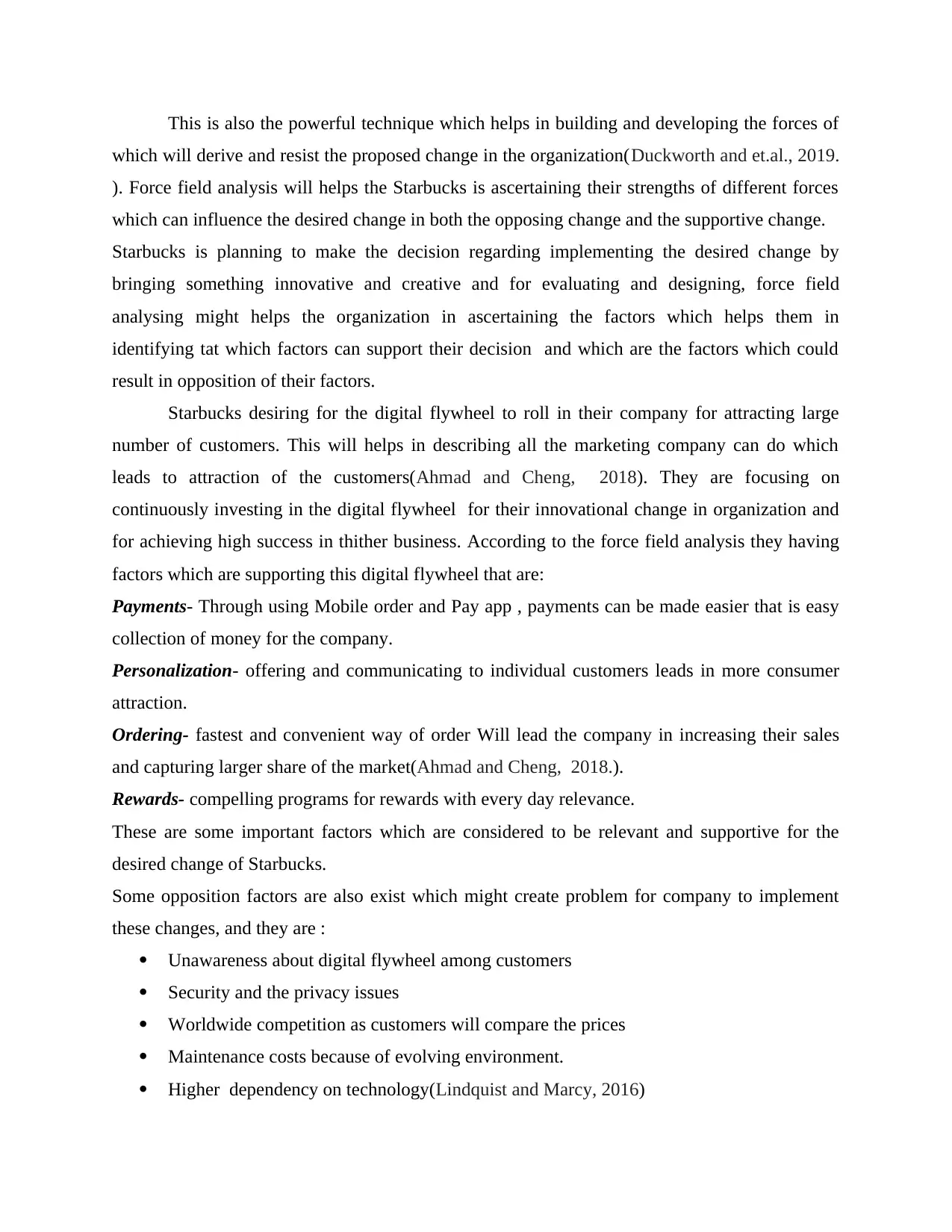
This is also the powerful technique which helps in building and developing the forces of
which will derive and resist the proposed change in the organization(Duckworth and et.al., 2019.
). Force field analysis will helps the Starbucks is ascertaining their strengths of different forces
which can influence the desired change in both the opposing change and the supportive change.
Starbucks is planning to make the decision regarding implementing the desired change by
bringing something innovative and creative and for evaluating and designing, force field
analysing might helps the organization in ascertaining the factors which helps them in
identifying tat which factors can support their decision and which are the factors which could
result in opposition of their factors.
Starbucks desiring for the digital flywheel to roll in their company for attracting large
number of customers. This will helps in describing all the marketing company can do which
leads to attraction of the customers(Ahmad and Cheng, 2018). They are focusing on
continuously investing in the digital flywheel for their innovational change in organization and
for achieving high success in thither business. According to the force field analysis they having
factors which are supporting this digital flywheel that are:
Payments- Through using Mobile order and Pay app , payments can be made easier that is easy
collection of money for the company.
Personalization- offering and communicating to individual customers leads in more consumer
attraction.
Ordering- fastest and convenient way of order Will lead the company in increasing their sales
and capturing larger share of the market(Ahmad and Cheng, 2018.).
Rewards- compelling programs for rewards with every day relevance.
These are some important factors which are considered to be relevant and supportive for the
desired change of Starbucks.
Some opposition factors are also exist which might create problem for company to implement
these changes, and they are :
Unawareness about digital flywheel among customers
Security and the privacy issues
Worldwide competition as customers will compare the prices
Maintenance costs because of evolving environment.
Higher dependency on technology(Lindquist and Marcy, 2016)
which will derive and resist the proposed change in the organization(Duckworth and et.al., 2019.
). Force field analysis will helps the Starbucks is ascertaining their strengths of different forces
which can influence the desired change in both the opposing change and the supportive change.
Starbucks is planning to make the decision regarding implementing the desired change by
bringing something innovative and creative and for evaluating and designing, force field
analysing might helps the organization in ascertaining the factors which helps them in
identifying tat which factors can support their decision and which are the factors which could
result in opposition of their factors.
Starbucks desiring for the digital flywheel to roll in their company for attracting large
number of customers. This will helps in describing all the marketing company can do which
leads to attraction of the customers(Ahmad and Cheng, 2018). They are focusing on
continuously investing in the digital flywheel for their innovational change in organization and
for achieving high success in thither business. According to the force field analysis they having
factors which are supporting this digital flywheel that are:
Payments- Through using Mobile order and Pay app , payments can be made easier that is easy
collection of money for the company.
Personalization- offering and communicating to individual customers leads in more consumer
attraction.
Ordering- fastest and convenient way of order Will lead the company in increasing their sales
and capturing larger share of the market(Ahmad and Cheng, 2018.).
Rewards- compelling programs for rewards with every day relevance.
These are some important factors which are considered to be relevant and supportive for the
desired change of Starbucks.
Some opposition factors are also exist which might create problem for company to implement
these changes, and they are :
Unawareness about digital flywheel among customers
Security and the privacy issues
Worldwide competition as customers will compare the prices
Maintenance costs because of evolving environment.
Higher dependency on technology(Lindquist and Marcy, 2016)
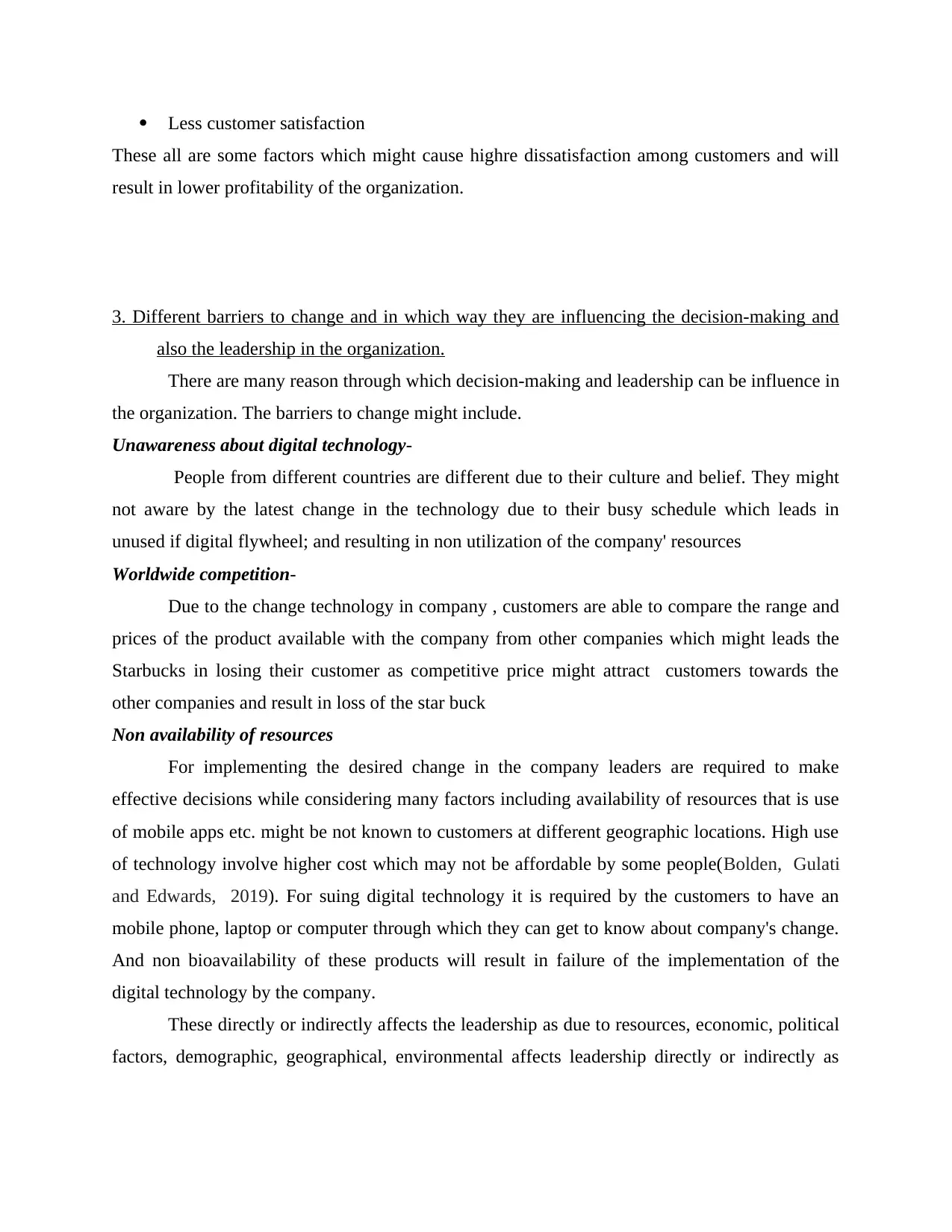
Less customer satisfaction
These all are some factors which might cause highre dissatisfaction among customers and will
result in lower profitability of the organization.
3. Different barriers to change and in which way they are influencing the decision-making and
also the leadership in the organization.
There are many reason through which decision-making and leadership can be influence in
the organization. The barriers to change might include.
Unawareness about digital technology-
People from different countries are different due to their culture and belief. They might
not aware by the latest change in the technology due to their busy schedule which leads in
unused if digital flywheel; and resulting in non utilization of the company' resources
Worldwide competition-
Due to the change technology in company , customers are able to compare the range and
prices of the product available with the company from other companies which might leads the
Starbucks in losing their customer as competitive price might attract customers towards the
other companies and result in loss of the star buck
Non availability of resources
For implementing the desired change in the company leaders are required to make
effective decisions while considering many factors including availability of resources that is use
of mobile apps etc. might be not known to customers at different geographic locations. High use
of technology involve higher cost which may not be affordable by some people(Bolden, Gulati
and Edwards, 2019). For suing digital technology it is required by the customers to have an
mobile phone, laptop or computer through which they can get to know about company's change.
And non bioavailability of these products will result in failure of the implementation of the
digital technology by the company.
These directly or indirectly affects the leadership as due to resources, economic, political
factors, demographic, geographical, environmental affects leadership directly or indirectly as
These all are some factors which might cause highre dissatisfaction among customers and will
result in lower profitability of the organization.
3. Different barriers to change and in which way they are influencing the decision-making and
also the leadership in the organization.
There are many reason through which decision-making and leadership can be influence in
the organization. The barriers to change might include.
Unawareness about digital technology-
People from different countries are different due to their culture and belief. They might
not aware by the latest change in the technology due to their busy schedule which leads in
unused if digital flywheel; and resulting in non utilization of the company' resources
Worldwide competition-
Due to the change technology in company , customers are able to compare the range and
prices of the product available with the company from other companies which might leads the
Starbucks in losing their customer as competitive price might attract customers towards the
other companies and result in loss of the star buck
Non availability of resources
For implementing the desired change in the company leaders are required to make
effective decisions while considering many factors including availability of resources that is use
of mobile apps etc. might be not known to customers at different geographic locations. High use
of technology involve higher cost which may not be affordable by some people(Bolden, Gulati
and Edwards, 2019). For suing digital technology it is required by the customers to have an
mobile phone, laptop or computer through which they can get to know about company's change.
And non bioavailability of these products will result in failure of the implementation of the
digital technology by the company.
These directly or indirectly affects the leadership as due to resources, economic, political
factors, demographic, geographical, environmental affects leadership directly or indirectly as
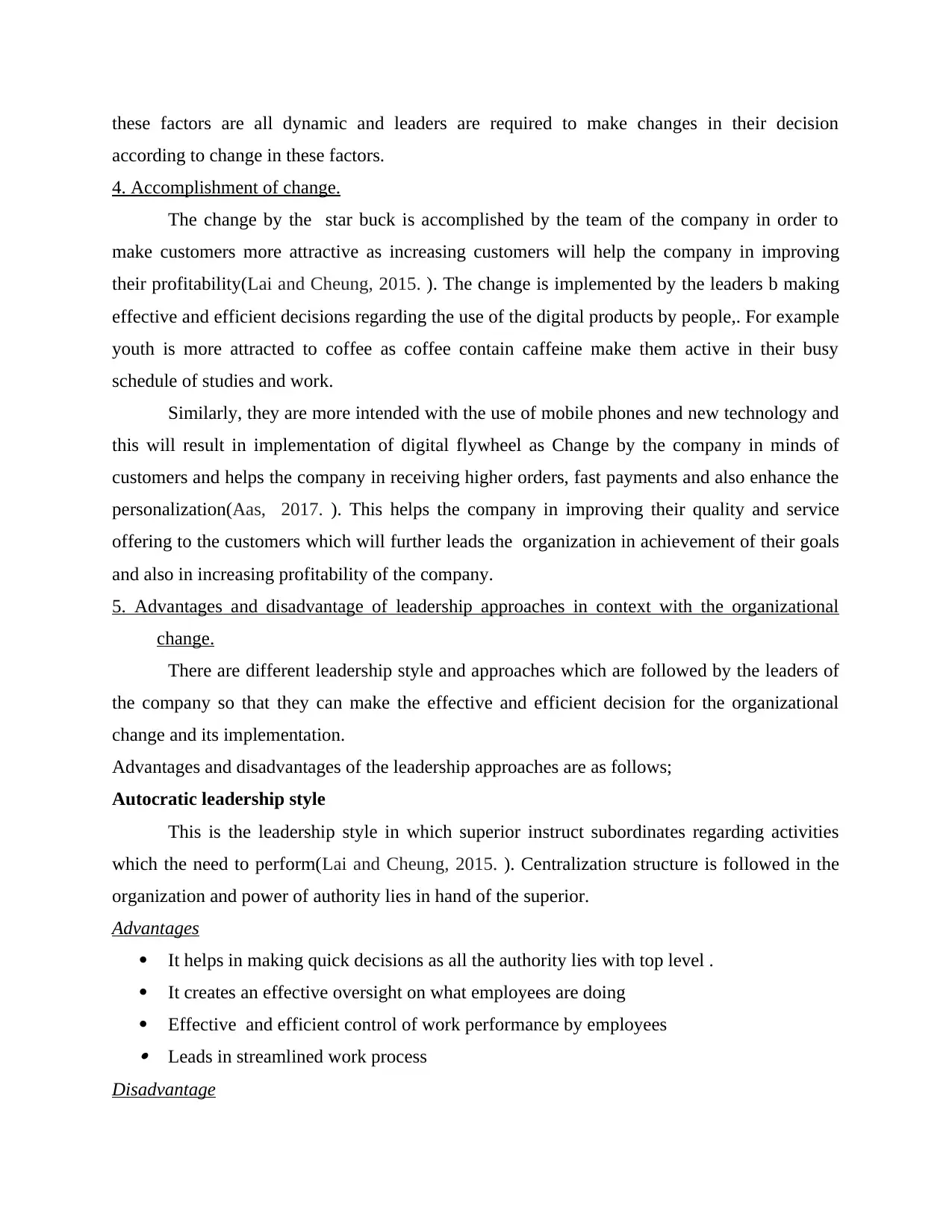
these factors are all dynamic and leaders are required to make changes in their decision
according to change in these factors.
4. Accomplishment of change.
The change by the star buck is accomplished by the team of the company in order to
make customers more attractive as increasing customers will help the company in improving
their profitability(Lai and Cheung, 2015. ). The change is implemented by the leaders b making
effective and efficient decisions regarding the use of the digital products by people,. For example
youth is more attracted to coffee as coffee contain caffeine make them active in their busy
schedule of studies and work.
Similarly, they are more intended with the use of mobile phones and new technology and
this will result in implementation of digital flywheel as Change by the company in minds of
customers and helps the company in receiving higher orders, fast payments and also enhance the
personalization(Aas, 2017. ). This helps the company in improving their quality and service
offering to the customers which will further leads the organization in achievement of their goals
and also in increasing profitability of the company.
5. Advantages and disadvantage of leadership approaches in context with the organizational
change.
There are different leadership style and approaches which are followed by the leaders of
the company so that they can make the effective and efficient decision for the organizational
change and its implementation.
Advantages and disadvantages of the leadership approaches are as follows;
Autocratic leadership style
This is the leadership style in which superior instruct subordinates regarding activities
which the need to perform(Lai and Cheung, 2015. ). Centralization structure is followed in the
organization and power of authority lies in hand of the superior.
Advantages
It helps in making quick decisions as all the authority lies with top level .
It creates an effective oversight on what employees are doing
Effective and efficient control of work performance by employees Leads in streamlined work process
Disadvantage
according to change in these factors.
4. Accomplishment of change.
The change by the star buck is accomplished by the team of the company in order to
make customers more attractive as increasing customers will help the company in improving
their profitability(Lai and Cheung, 2015. ). The change is implemented by the leaders b making
effective and efficient decisions regarding the use of the digital products by people,. For example
youth is more attracted to coffee as coffee contain caffeine make them active in their busy
schedule of studies and work.
Similarly, they are more intended with the use of mobile phones and new technology and
this will result in implementation of digital flywheel as Change by the company in minds of
customers and helps the company in receiving higher orders, fast payments and also enhance the
personalization(Aas, 2017. ). This helps the company in improving their quality and service
offering to the customers which will further leads the organization in achievement of their goals
and also in increasing profitability of the company.
5. Advantages and disadvantage of leadership approaches in context with the organizational
change.
There are different leadership style and approaches which are followed by the leaders of
the company so that they can make the effective and efficient decision for the organizational
change and its implementation.
Advantages and disadvantages of the leadership approaches are as follows;
Autocratic leadership style
This is the leadership style in which superior instruct subordinates regarding activities
which the need to perform(Lai and Cheung, 2015. ). Centralization structure is followed in the
organization and power of authority lies in hand of the superior.
Advantages
It helps in making quick decisions as all the authority lies with top level .
It creates an effective oversight on what employees are doing
Effective and efficient control of work performance by employees Leads in streamlined work process
Disadvantage
Secure Best Marks with AI Grader
Need help grading? Try our AI Grader for instant feedback on your assignments.
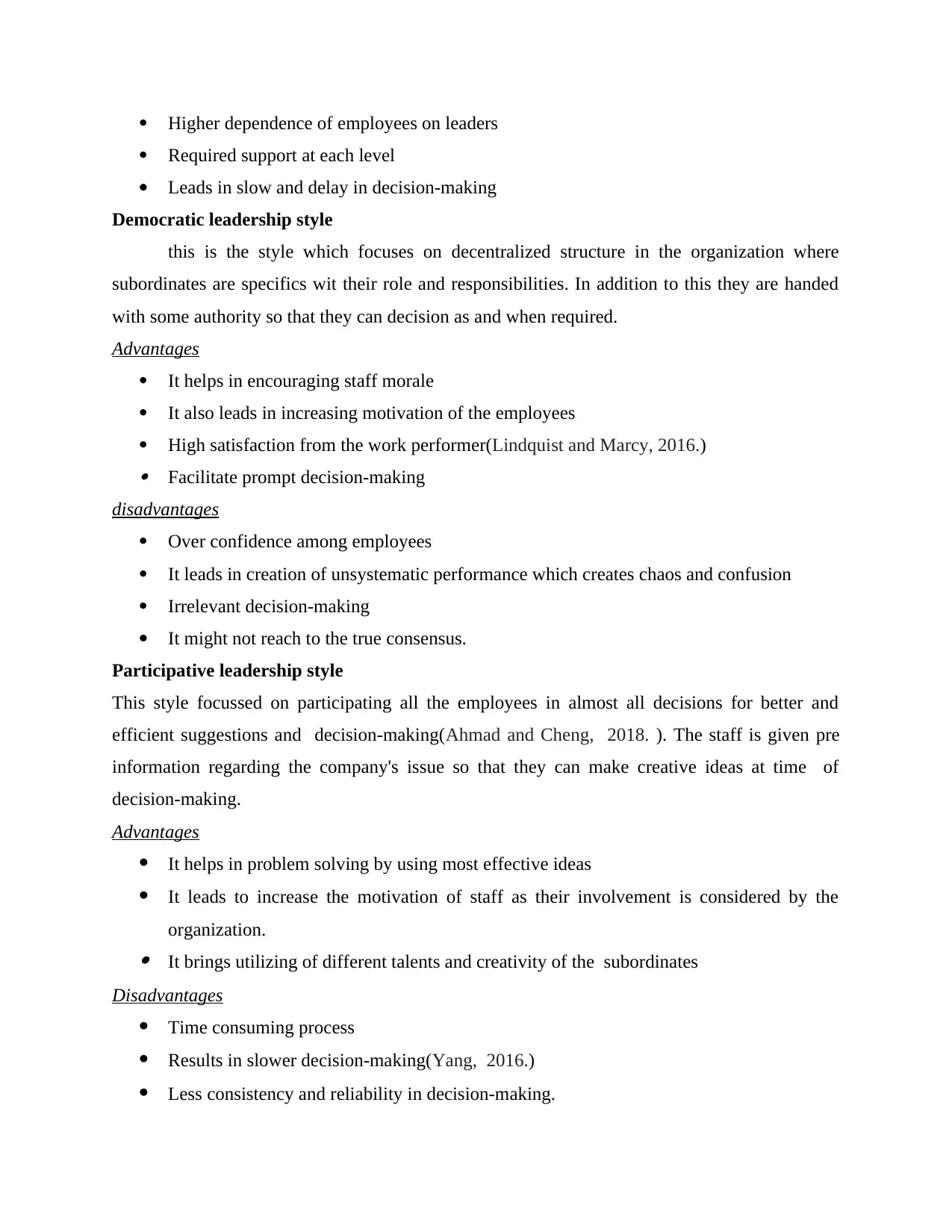
Higher dependence of employees on leaders
Required support at each level
Leads in slow and delay in decision-making
Democratic leadership style
this is the style which focuses on decentralized structure in the organization where
subordinates are specifics wit their role and responsibilities. In addition to this they are handed
with some authority so that they can decision as and when required.
Advantages
It helps in encouraging staff morale
It also leads in increasing motivation of the employees
High satisfaction from the work performer(Lindquist and Marcy, 2016.) Facilitate prompt decision-making
disadvantages
Over confidence among employees
It leads in creation of unsystematic performance which creates chaos and confusion
Irrelevant decision-making
It might not reach to the true consensus.
Participative leadership style
This style focussed on participating all the employees in almost all decisions for better and
efficient suggestions and decision-making(Ahmad and Cheng, 2018. ). The staff is given pre
information regarding the company's issue so that they can make creative ideas at time of
decision-making.
Advantages
It helps in problem solving by using most effective ideas
It leads to increase the motivation of staff as their involvement is considered by the
organization. It brings utilizing of different talents and creativity of the subordinates
Disadvantages
Time consuming process
Results in slower decision-making(Yang, 2016.)
Less consistency and reliability in decision-making.
Required support at each level
Leads in slow and delay in decision-making
Democratic leadership style
this is the style which focuses on decentralized structure in the organization where
subordinates are specifics wit their role and responsibilities. In addition to this they are handed
with some authority so that they can decision as and when required.
Advantages
It helps in encouraging staff morale
It also leads in increasing motivation of the employees
High satisfaction from the work performer(Lindquist and Marcy, 2016.) Facilitate prompt decision-making
disadvantages
Over confidence among employees
It leads in creation of unsystematic performance which creates chaos and confusion
Irrelevant decision-making
It might not reach to the true consensus.
Participative leadership style
This style focussed on participating all the employees in almost all decisions for better and
efficient suggestions and decision-making(Ahmad and Cheng, 2018. ). The staff is given pre
information regarding the company's issue so that they can make creative ideas at time of
decision-making.
Advantages
It helps in problem solving by using most effective ideas
It leads to increase the motivation of staff as their involvement is considered by the
organization. It brings utilizing of different talents and creativity of the subordinates
Disadvantages
Time consuming process
Results in slower decision-making(Yang, 2016.)
Less consistency and reliability in decision-making.
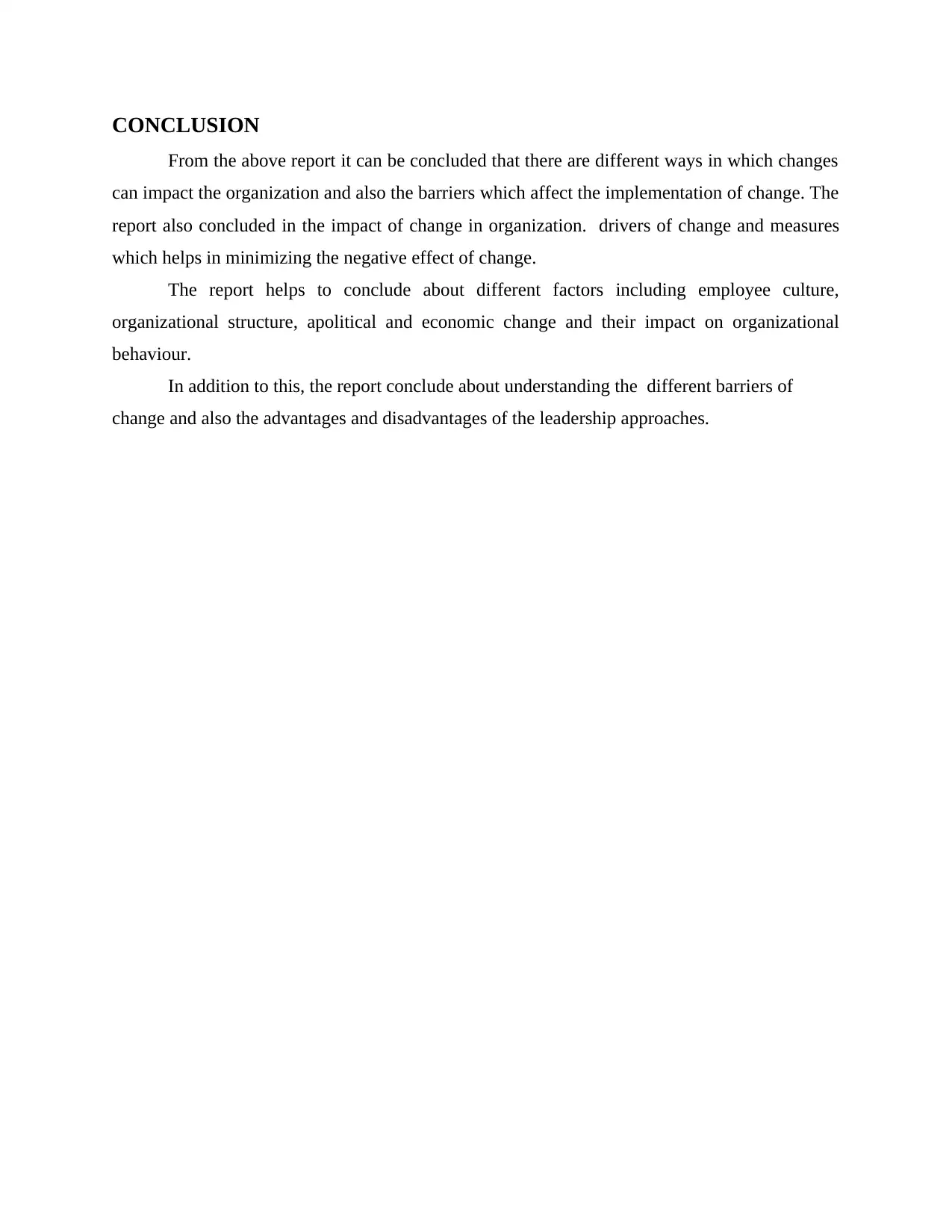
CONCLUSION
From the above report it can be concluded that there are different ways in which changes
can impact the organization and also the barriers which affect the implementation of change. The
report also concluded in the impact of change in organization. drivers of change and measures
which helps in minimizing the negative effect of change.
The report helps to conclude about different factors including employee culture,
organizational structure, apolitical and economic change and their impact on organizational
behaviour.
In addition to this, the report conclude about understanding the different barriers of
change and also the advantages and disadvantages of the leadership approaches.
From the above report it can be concluded that there are different ways in which changes
can impact the organization and also the barriers which affect the implementation of change. The
report also concluded in the impact of change in organization. drivers of change and measures
which helps in minimizing the negative effect of change.
The report helps to conclude about different factors including employee culture,
organizational structure, apolitical and economic change and their impact on organizational
behaviour.
In addition to this, the report conclude about understanding the different barriers of
change and also the advantages and disadvantages of the leadership approaches.
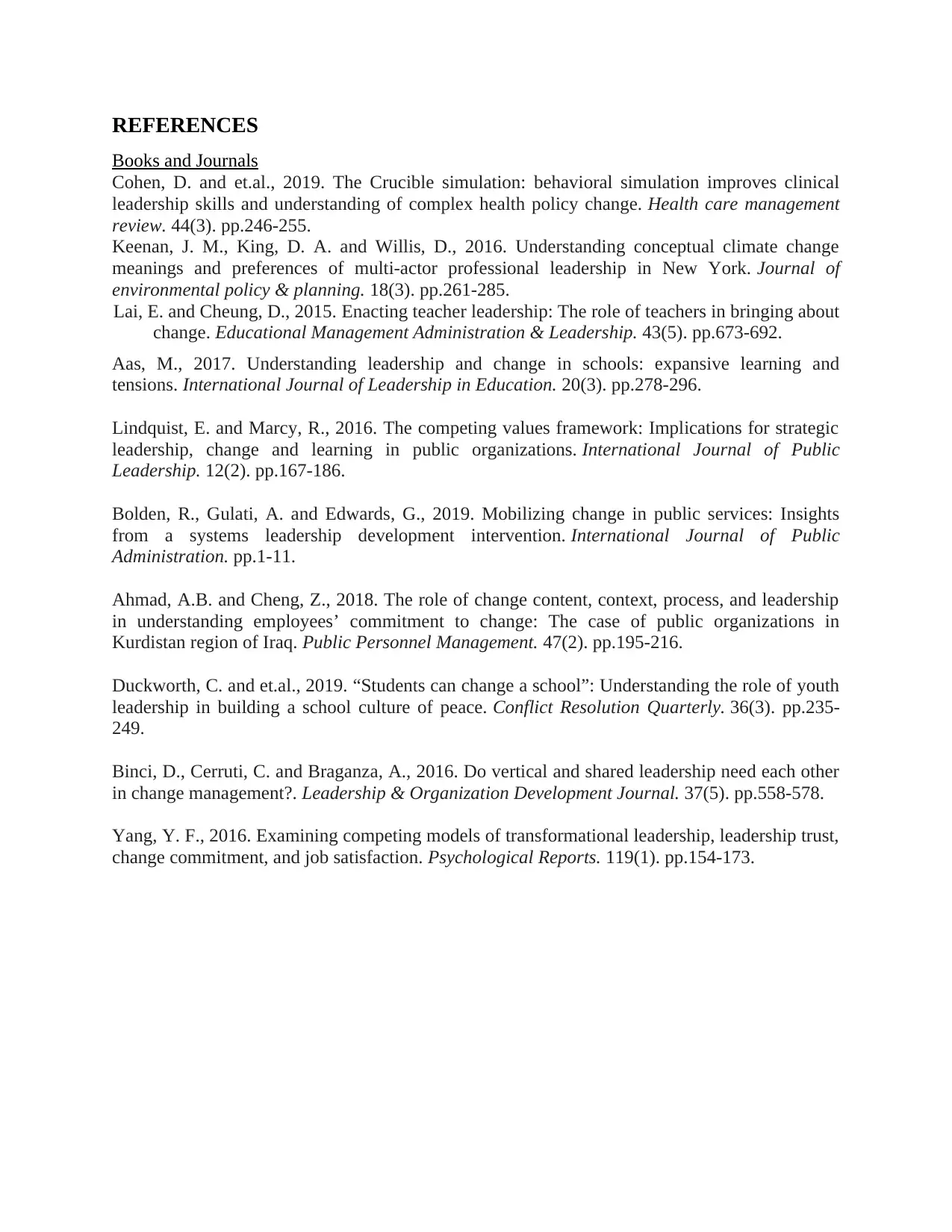
REFERENCES
Books and Journals
Cohen, D. and et.al., 2019. The Crucible simulation: behavioral simulation improves clinical
leadership skills and understanding of complex health policy change. Health care management
review. 44(3). pp.246-255.
Keenan, J. M., King, D. A. and Willis, D., 2016. Understanding conceptual climate change
meanings and preferences of multi-actor professional leadership in New York. Journal of
environmental policy & planning. 18(3). pp.261-285.
Lai, E. and Cheung, D., 2015. Enacting teacher leadership: The role of teachers in bringing about
change. Educational Management Administration & Leadership. 43(5). pp.673-692.
Aas, M., 2017. Understanding leadership and change in schools: expansive learning and
tensions. International Journal of Leadership in Education. 20(3). pp.278-296.
Lindquist, E. and Marcy, R., 2016. The competing values framework: Implications for strategic
leadership, change and learning in public organizations. International Journal of Public
Leadership. 12(2). pp.167-186.
Bolden, R., Gulati, A. and Edwards, G., 2019. Mobilizing change in public services: Insights
from a systems leadership development intervention. International Journal of Public
Administration. pp.1-11.
Ahmad, A.B. and Cheng, Z., 2018. The role of change content, context, process, and leadership
in understanding employees’ commitment to change: The case of public organizations in
Kurdistan region of Iraq. Public Personnel Management. 47(2). pp.195-216.
Duckworth, C. and et.al., 2019. “Students can change a school”: Understanding the role of youth
leadership in building a school culture of peace. Conflict Resolution Quarterly. 36(3). pp.235-
249.
Binci, D., Cerruti, C. and Braganza, A., 2016. Do vertical and shared leadership need each other
in change management?. Leadership & Organization Development Journal. 37(5). pp.558-578.
Yang, Y. F., 2016. Examining competing models of transformational leadership, leadership trust,
change commitment, and job satisfaction. Psychological Reports. 119(1). pp.154-173.
Books and Journals
Cohen, D. and et.al., 2019. The Crucible simulation: behavioral simulation improves clinical
leadership skills and understanding of complex health policy change. Health care management
review. 44(3). pp.246-255.
Keenan, J. M., King, D. A. and Willis, D., 2016. Understanding conceptual climate change
meanings and preferences of multi-actor professional leadership in New York. Journal of
environmental policy & planning. 18(3). pp.261-285.
Lai, E. and Cheung, D., 2015. Enacting teacher leadership: The role of teachers in bringing about
change. Educational Management Administration & Leadership. 43(5). pp.673-692.
Aas, M., 2017. Understanding leadership and change in schools: expansive learning and
tensions. International Journal of Leadership in Education. 20(3). pp.278-296.
Lindquist, E. and Marcy, R., 2016. The competing values framework: Implications for strategic
leadership, change and learning in public organizations. International Journal of Public
Leadership. 12(2). pp.167-186.
Bolden, R., Gulati, A. and Edwards, G., 2019. Mobilizing change in public services: Insights
from a systems leadership development intervention. International Journal of Public
Administration. pp.1-11.
Ahmad, A.B. and Cheng, Z., 2018. The role of change content, context, process, and leadership
in understanding employees’ commitment to change: The case of public organizations in
Kurdistan region of Iraq. Public Personnel Management. 47(2). pp.195-216.
Duckworth, C. and et.al., 2019. “Students can change a school”: Understanding the role of youth
leadership in building a school culture of peace. Conflict Resolution Quarterly. 36(3). pp.235-
249.
Binci, D., Cerruti, C. and Braganza, A., 2016. Do vertical and shared leadership need each other
in change management?. Leadership & Organization Development Journal. 37(5). pp.558-578.
Yang, Y. F., 2016. Examining competing models of transformational leadership, leadership trust,
change commitment, and job satisfaction. Psychological Reports. 119(1). pp.154-173.
1 out of 13
Related Documents
Your All-in-One AI-Powered Toolkit for Academic Success.
+13062052269
info@desklib.com
Available 24*7 on WhatsApp / Email
![[object Object]](/_next/static/media/star-bottom.7253800d.svg)
Unlock your academic potential
© 2024 | Zucol Services PVT LTD | All rights reserved.





